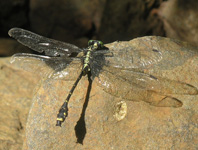Abstract
Notozulia entreriana (Berg) (Hemiptera: Cercopidae) is one of the most common spittlebugs inhabiting the subtropical region of the America, inflicting important economic damage to grass crops. The immature stages are described and illustrated; the main characteristics that distinguish instars are the body size, color, number of flagellomeres, and number of tibial and metatarsomere spines. A key for identification of nymphs is provided as a tool to develop field studies. Nine host plants, all belonging to Poaceae, are recorded as breeding and feeding host plants from different localities in northern Argentina.
References
Berg, C. (1879) Hemiptera Argentina. Enumeravit Speciesque Novas. Anales de la Sociedad Científica Argentina, 8, 230–238.
Burckhardt, D., Ouvrard, D., Queiroz, D. & Percy, D. (2014) Psyllid host-plants (Hemiptera: Psylloidea): Resolving a semantic problem. Florida Entomologist, 97 (1), 242–246.
http://dx.doi.org/10.1653/024.097.0132Carvalho, G.S. (1995) Cercopídeos neotropicais: Redescrição de Notozulia Fennah, stat. n. (Auchenorrhyncha: Cercopidae). Anais da Sociedade Entomológica do Brasil, 24, 385–388.
Cavichioli, R.R. (1987) Sobre a biologia de Kanaima fluvialis (Lalleman, 1924) (Homoptera, Cercopidae). Revista Brasileira de Entomologia, 31 (1), 71–82.
Cavichioli, R.R. (1988) Estudo sobre a morfología de Kanaima fluvialis (Lallemand, 1924) (Homoptera, Cercopidae). Revista Brasilera de Entomologia, 32 (3/4), 393–410.
Domingues, J.M. & Da Silva Santos, E.M. (1975) Estudo da biologia da cigarrinha das pastagens Zulia entreriana Berg, 1879, e sua curva populacional no norte do estado do spirito santo. Boletim Técnico n°2. EMPCAPA, 1–48.
Ferreira De Lima, M. (1983) Flutuação populacional de Zulia entreriana em pastagens Brachiaria decumbens, Cenchrus ciliares e Digitaria decumbens, em diferentes regioes do estado de Sergipe. Pesquisa em Andamento. EMBRAPA-UEPAE, 1–5.
Fewkes, D.W. (1969) The biology of sugar cane froghoppers. In: Williams, J.R., Metcalfe, J.R., Mongomery, R.W. & Mathes, R. (Eds), Pests of Sugar Cane. Amsterdam, Elsevier. pp. 283–307.
Foieri, A., Virla, G.E. & Marino De Remes Lenicov, A.M. (2015) New host plants records for the froghopper Notozulia entreriana (Hemiptera: Cercopidae) with new data on its occurrence in diverse ecological zones in Argentina. Revista de la Sociedad Entomologica Argentina, 74 (1–2), 79–84.
Guagliumi, P. (1957) Contribuciones al estudio de la candelilla de las gramíneas en Venezuela. III. Cuadro de distribución geográfica de las especies de Aeneolamia Fennah y sus plantas hospederas señaladas en Venezuela. Agronomia Tropical, 6, 165–194.
Heinrichs, E.A. & Barrion, A.T. (2004) Rice-feeding insects and selected natural enemies in West Africa: Biology, ecology, identification. International Rice Research Institute, Los Baños, Philippines. pp. 1–242.
Holmann, F. & Peck, C. (2002) Economic damage caused by spittlebugs (Homoptera: Cercopidae) in Colombia: a first approximation of impact on animal production in Brachiaria decumbens pastures. Neotropical Entomology, 31 (2), 275–28.
http://dx.doi.org/10.1590/S1519-566X2002000200016Koller, W.W. & Valério, J.R. (1984) Padrões alares em Zulia entreriana em Campo Grande, MS. Pesquisa Agropecuária Brasileira, 19 (7), 799–803.
Koller, W.W. & Honer, M.R. (1993) Correlações entre fatores climáticos e a dinâmica de produção de ovos diapáusicos de duas espécies de cigarrinhas-das-pastagens (Homoptera; Cercopidae). Anais da Sociedade Entomológica do Brasil, 22 (3), 597–621.
Lapointe, S. & Sonoda, R.M. (2001) The effect of arthropods, disease, and nematodes on tropical pastures. In Sotomayor-Rios, A. & Pitman, W.D. (Eds.), Tropical Forage Plants: Development and Use. Boca Raton, CRC Press. pp. 201–218.
Leite, L.G., Machado, L.A., Goulart, R.M., Tavares, F.M. & Filho, A.B. (2005) Screening of entomopathogenic nematodes (Nemata: Rhabditida) and the efficiency of Heterorhabditis sp. against the sugarcane root spittlebug Mahanarva fimbriolata (Fabr.) (Hemiptera: Cercopidae). Neotropical Entomology, 34, 785–790.
http://dx.doi.org/10.1590/S1519-566X2005000500010Liang, A.-P. & Fletcher, M. (2002) Morphology of the antennal sensilla in four Australian spittlebug species (Hemiptera: Cercopidae) with implications for phylogeny. Australian Journal of Entomology, 41, 39–44.
http://dx.doi.org/10.1046/j.1440-6055.2002.00266.xMiles, P.W. (1989) The responses of plants to the feeding of Aphidoidea: principles. In: Minks, A.K. & Harrewijn, P. (Eds.), Aphids, Their Biology, Natural Enemies and Control, Elsevier, Amsterdam. Vol C. pp. 1–21.
Paladini, A., Carvalho, G.S. & Valério, J.R. (2008) Ultrastructure and redescription of Notozulia entreriana (Berg) (Hemiptera: Cercopidae). Neotropical Entomology, 37 (5), 552–557.
http://dx.doi.org/10.1590/S1519-566X2008000500008Peck, D.C. (1998) Natural history of the spittlebug Prosapia nr. bicincta (Homoptera : Cercopidae) in association with hairy pastures of Costa Rica. Annals of the Entomological Society of America, 91 (4), 435–444.
http://dx.doi.org/10.1093/aesa/91.4.435Peck, D.C. (2001) Diversidad y distribución geográfica del salivazo (Homoptera: Cercopidae) asociado con gramíneas en Colombia y Ecuador. Revista Colombiana Entomología, 27 (3/4), 129–136.
Peck, D.C. (2002) Distribución y reconocimiento del salivazo de los pastos (Homoptera: Cercopidae) en la Costa Caribe de Colombia. Pasturas Tropicales, 24 (1), 1–15.
Pires, S.S., Suji, E.R., Fontes, E.M.G, Tauber, C.A. & Tauber, M.J. (2000) Dry-season dormancy in eggs of Deois flavopicta (Homoptera: Cercopidae): roles of temperature and moisture in nature. Environmental Entomology, 29, 714–720.
http://dx.doi.org/10.1603/0046-225X-29.4.714Ringenberg, R., Spotti Lopes, J.R., Müller, C., Sampaio De Azevedo-Filho, W., Jordão Paranhos, B.A. & Botton, M. (2014) Survey of potential sharpshooter and spittlebug vectors of Xylella fastidiosa to grapevines at the São Francisco River Valley, Brazil. Revista Brasileira de Entomologia, 212–214.
http://dx.doi.org/10.1590/S0085-56262014000200013Rodman, D.H. & Miller, D.J. (1992) Enzyme activities with salivary glands of the froghopper Eoscarta carnifex (F.) (Homoptera: Cercopidae): possible role of salivary catalase in phytotoxicity. Australian Journal of Zoology, 40 (4), 365–370.
http://dx.doi.org/10.1071/ZO9920365Sanz, N.T. (1997) Checklist of Pests and Diseases of Selected Crops of Belize. Belize National Plant Protection Service, Ministry of Agriculture and Fisheries, Central Farm, Cayo District.
Savatin, D.V., Gramegna, G., Modesti, V. & Cervone, F. (2014) Wounding in the plant tissue: the defense of a dangerous passage. Frontiers in Plant Science, 5, 470–476.
http://dx.doi.org/10.3389/fpls.2014.00470Saponari, M., Loconsole, G., Cornara, D., Yokomi, K.R., De Stradis, A., Boscia, D., Bosco, D., Martelli, G.P., Krugner. R. & Porcelli, F. (2014) Infectivity and transmission of Xylella fastidiosa by Philaenus spumarius (Hemiptera: Cercopidae) in Apulia, Italy. Journal of Economic Entomology, 107, 1–4.
http://dx.doi.org/10.1603/EC14142Thompson, V. (2004) Associative nitrogen fixation, C4 photosynthesis, and the evolution of spittlebugs (Hemiptera: Cercopidae) as major pest of Neotropical sugarcane and forage grasses. Bulletin of Entomological Research, 94 (1), 189–200.
http://dx.doi.org/10.1079/ber2004293Valério, J.R. (2009) Cigarrinhas-das-pastagens. Documentos 179. EMBRAPA, 1–50.

